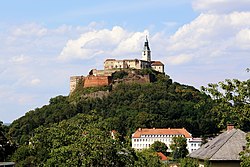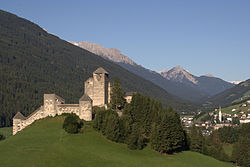
Hohenwang is a ruined castle in Municipality of Langenwang, Styria, Austria. It stands on a hill at an elevation of 650 metres above sea level. [1]
Contents
The castle, whose core dates back to the 12th century, is the symbol of Langenwang, and because of its exceptional length one of the largest castles in Styria.
It consists of a stronghold and two outworks, which are separated by trenches. The castle's massive decline began in the late 18th century, after it was severely damaged by an earthquake. During World War II more parts of the ruins were destroyed by bombing.
From the fortress, the shield wall of the high castle and the main gate are preserved in their perimeter today. The walls were mostly secured and renovated in the last 40 years by members of the Association Hohenwang castle.
Hohenwang served as a local administrative center, as protection of the population in times of crisis, and assisted in the spread of Christianity in the upper Muerztal. From the 13th century on, a priest resided at the castle.
Despite the regional importance their owners were allowed only to exercise the powers of the lower courts. Offenders who had been guilty of felony, had to be transferred to the district court in Kapfenberg.
It is an elongated complex with a stronghold, a deeper front castle with gatehouses and a curtain wall. It is oriented from southwest to northeast and extends over a total length of 90 meters. A donjon was not available. From the 13th to the 17th century, the romanesque core eastward to the Palas, a gallery, a kennel, a bastion and a representative gatehouse were enlarged. There exists a more detailed description of the interior of the castle in a 15th-century chronicle; a chapel, a servants' room, a large hall, four cellars, a bath-room, a kitchen and a stable for twelve horses are all mentioned. The three well-secured gates, - two of which provided with a slip gate - the attachment to the ditch and finally the very steep cliffs to the south, west and north made a storming of the fortress a difficult task. In addition to the engraving by Georg Matthäus Vischer, the castle is also shown on a proclamation image that had been given to Ulrich Christoph von Scherffenberg in 1631.









